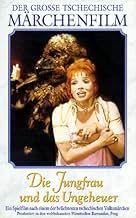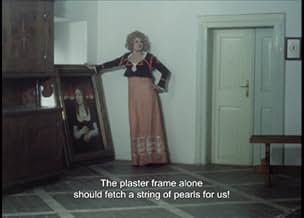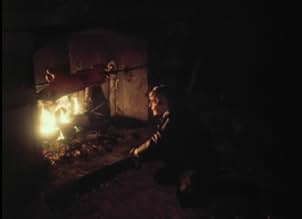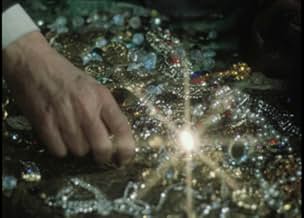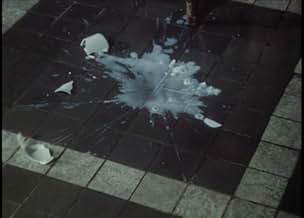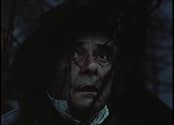NOTE IMDb
7,5/10
2,1 k
MA NOTE
Ajouter une intrigue dans votre langueIn this gothic rendition of the classic fairy tale, a merchant's youngest daughter is held prisoner by a mysterious winged beast.In this gothic rendition of the classic fairy tale, a merchant's youngest daughter is held prisoner by a mysterious winged beast.In this gothic rendition of the classic fairy tale, a merchant's youngest daughter is held prisoner by a mysterious winged beast.
- Réalisation
- Scénario
- Casting principal
- Récompenses
- 2 victoires et 1 nomination au total
Jorga Kotrbová
- Málinka
- (voix)
Tatjana Medvecká
- Julie
- (voix)
Avis à la une
This is such a strange film. Nominally a Beauty and the Beast rendition (the title translates to Virgin and the Monster), it is introspective wandering through dreams. It is both rich in what we see of dreams and silly. The filmmaker (Juraj Herz, also responsible for Cremator) juggles various moods, sombre elegy to medieval fairytale.
As you watch it, it may strike you as both obvious and muddled, obvious because its fantasy is of the schematic sort, with onedimensional characters like the 'kindly father', 'innocent maiden', 'petty step- sisters'. The monster looks silly. So it may seem like it's not worth the effort of bridging the distance to what is going on behind the simplistic surface.
However, scrap all that and this may get to you. It got to me, at least for a while. It isn't about just the Gothic mood. Its appeal is a series of interleavened dreams, but you aren't always sure who is dreaming, if sometimes more than one dreamer, and when one bleeds into the next, so you drift with it.
Consider this as the story. A rich merchant father has to marry off his daughter in a marriage of convenience, the anxiety this causes to both is at the root of the film. It isn't in the film as such, but you will get something of the sort if you conflate the different threads.
From the father's perspective, this means sending off his daughter to live with a 'monster' in his dark lair, from her perspective, it means going to live alone with a stranger, her fate sealed. This translates in several scenes of hallucination, all of it wonderfully visual—the ominous destruction of the merchant wares in the woods, the father's deal with the monster for the girl, the girl's gilded dream of a handsome prince (inside a coffin) and half-frightful, half-anticipatory wandering in the mansion hearing just his voice.
The plucking of roses as loss of purity is a central motif.
It's silly again as we shift to the monster's soliloquies of what it means to be human, but that is because we don't have a surrogate for him in the level of reality, he solely exists inside the fantasy as the abstract ogre made human by her touch. The Czech often favor a juvenile theatricality.
But there's something else that is cool. Now so far all points to constructed realities, dreams as tailored emotional space. The girl wonders if she's not imagining everything, in one scene she visits as ghostly observer her sisters' wedding, no one can see her.
Here's how the filmmaker adds layers to the monster. He has conflicting sides to him, two voices that ponder on whether to kill or spare the girl. The 'evil' voice is disembodied, in his mind. This 'evil' narrator is coming from the camera, you'll notice this is linked with subjective shots of the monster as it kills the wench in the woods, roams with a candelabra and early on 'stages' the frightful visit of the father. It's the filmmaker's hand (as internal consciousness shaping the story) pushing for horror, very cool to see.
So as with many films of this sort, the film becomes more disposable the more you settle on what the story is supposed to be. It fits somewhere between Lynch, Hourglass Sanatorium for nested doll-worlds, Jean Rollin's wandering and Valerie's Week of Wonders.
I listed the films (and makers) in descending order of preference, which for me is the order by which, as you peel away layers, you get less and less of what you thought is there, it opens up, instead of a single solid core. Angels dancing instead of a pin's head.
So if you want a cryptic story disguised to mean something, this is cryptic but as with Rollin and Valerie it makes rather simple sense. At the same time, it is dissonant enough once you disengage from story to captivate. I will see if I can track down more from this guy, he may deserve a place in my nightly viewings.
As you watch it, it may strike you as both obvious and muddled, obvious because its fantasy is of the schematic sort, with onedimensional characters like the 'kindly father', 'innocent maiden', 'petty step- sisters'. The monster looks silly. So it may seem like it's not worth the effort of bridging the distance to what is going on behind the simplistic surface.
However, scrap all that and this may get to you. It got to me, at least for a while. It isn't about just the Gothic mood. Its appeal is a series of interleavened dreams, but you aren't always sure who is dreaming, if sometimes more than one dreamer, and when one bleeds into the next, so you drift with it.
Consider this as the story. A rich merchant father has to marry off his daughter in a marriage of convenience, the anxiety this causes to both is at the root of the film. It isn't in the film as such, but you will get something of the sort if you conflate the different threads.
From the father's perspective, this means sending off his daughter to live with a 'monster' in his dark lair, from her perspective, it means going to live alone with a stranger, her fate sealed. This translates in several scenes of hallucination, all of it wonderfully visual—the ominous destruction of the merchant wares in the woods, the father's deal with the monster for the girl, the girl's gilded dream of a handsome prince (inside a coffin) and half-frightful, half-anticipatory wandering in the mansion hearing just his voice.
The plucking of roses as loss of purity is a central motif.
It's silly again as we shift to the monster's soliloquies of what it means to be human, but that is because we don't have a surrogate for him in the level of reality, he solely exists inside the fantasy as the abstract ogre made human by her touch. The Czech often favor a juvenile theatricality.
But there's something else that is cool. Now so far all points to constructed realities, dreams as tailored emotional space. The girl wonders if she's not imagining everything, in one scene she visits as ghostly observer her sisters' wedding, no one can see her.
Here's how the filmmaker adds layers to the monster. He has conflicting sides to him, two voices that ponder on whether to kill or spare the girl. The 'evil' voice is disembodied, in his mind. This 'evil' narrator is coming from the camera, you'll notice this is linked with subjective shots of the monster as it kills the wench in the woods, roams with a candelabra and early on 'stages' the frightful visit of the father. It's the filmmaker's hand (as internal consciousness shaping the story) pushing for horror, very cool to see.
So as with many films of this sort, the film becomes more disposable the more you settle on what the story is supposed to be. It fits somewhere between Lynch, Hourglass Sanatorium for nested doll-worlds, Jean Rollin's wandering and Valerie's Week of Wonders.
I listed the films (and makers) in descending order of preference, which for me is the order by which, as you peel away layers, you get less and less of what you thought is there, it opens up, instead of a single solid core. Angels dancing instead of a pin's head.
So if you want a cryptic story disguised to mean something, this is cryptic but as with Rollin and Valerie it makes rather simple sense. At the same time, it is dissonant enough once you disengage from story to captivate. I will see if I can track down more from this guy, he may deserve a place in my nightly viewings.
It's difficult to get past the opening scenes of close-ups of animal abuse, but at least that sets the tone for this very dark and murky adaption of the famous story. They say the acting life can be very glamorous - it certainly isn't the case here. No CGI safety-net, the performers attached to this story certainly seem to suffer for their art in a variety of uncomfortably cold situations.
It's good when horror films bring some new locations into their stories, but equally, it's always worth it to revisit the vast crumbling lairs of traditional settings, and that is done really effectively here; the story is given the most impressive horror treatment. Creatures hide in shadow - you only know they're there when you see a rolled eyeball or a moving, inhuman talon. There is enough of a fairytale quality to this to appeal to the inner child, and there are moments when the eyes will moisten! It's all accompanied by wonderful, sepulchral music, and directed like a hugely gothic TV film. My score is 8 out of 10.
It's good when horror films bring some new locations into their stories, but equally, it's always worth it to revisit the vast crumbling lairs of traditional settings, and that is done really effectively here; the story is given the most impressive horror treatment. Creatures hide in shadow - you only know they're there when you see a rolled eyeball or a moving, inhuman talon. There is enough of a fairytale quality to this to appeal to the inner child, and there are moments when the eyes will moisten! It's all accompanied by wonderful, sepulchral music, and directed like a hugely gothic TV film. My score is 8 out of 10.
10Atulur
Although I doubt that this film was ever on in the U.S., since I live in the country where it was shot, I can warmly recommend it to anyone who loves fairy tales taken in a harsher and darker manner. The atmosphere of the film is gloomy and the camera is very original - we can see the Beast /who has here gruesome bird-like looks/ only in the middle of the film. In the first part of the film we feel his presence only through his eyes. The beginning of the movie has nothing to do with a fairy tale, it is a pure horror - a dark forest, amazing church-pipe tones, chilling to the bone, mist all around and a sudden sound of hoofs getting nearer and nearer... The dark atmosphere of the whole film is weakend by a dream interlude in which the Monster is shown as a normal human being dancing with the heroine in rooms full of glare and light. Fantastic music again. Perfect acting /best Czech actors whatsover, great choreography/,a super setting /a dark palace of the Monster/. The film will give you a totally different approach to the old well known fairy tale.
9mar9
SBS-TV used to screen this film on an annual basis, but it has been missing in action for some years, which is cause for regret. The title may seem obscure, but a look at the alternative English translations ("Maiden and the Beast" and "Virgin and the Monster") should make this clearer. This is quite simply a wonderful interpretation of the classic fairy tale of Beauty and the Beast, produced and filmed in the then Czechoslovakia. Cinematic gems can be found in what may be thought to be unlikely places, and this film is an example.
Students of cinema may be aware that Cocteau did a version of this story in B&W, and there is of course the more recent and rather tame Disney version. This film is a very different proposition. For a start, it is unsuitable for young children because of some fairly graphic violence, including scenes of animal cruelty. The film-makers seem to strive for realism, particularly the scenes in the village where Beauty (here called Julie) lives, all mud and images of earthy rural life before the Industrial Revolution. But even the magical bits are portrayed realistically. The Beast's castle is maintained by an array of goblin-like servants, who skulk in the shadows of the fireplaces and chandeliers. If I have one complaint about this film, it is that the scenes are sometimes so dark that it is difficult to see what's happening. This does heighten tension, but it can be overdone.
The actors are great, especially the two charismatic leads. The Beast (Vlastimil Harapes) is fashioned more as a great bird of prey than Cocteau's leonine creation, and there is great suspense as he struggles with his inner violent nature (a sinister whispering voice) that is urging him to remain in his beastly form and kill the innocent Julie. Julie (Zdena Studenková) in turn is wonderfully portrayed. We can see why she is so obviously her father's favourite.
Fairy tales are expositions of the human condition, and the Beauty and the Beast story is no different. "Every woman has the power the make the one she loves beautiful". It's a simple theme, but this film explores it beautifully. See it if you can.
Students of cinema may be aware that Cocteau did a version of this story in B&W, and there is of course the more recent and rather tame Disney version. This film is a very different proposition. For a start, it is unsuitable for young children because of some fairly graphic violence, including scenes of animal cruelty. The film-makers seem to strive for realism, particularly the scenes in the village where Beauty (here called Julie) lives, all mud and images of earthy rural life before the Industrial Revolution. But even the magical bits are portrayed realistically. The Beast's castle is maintained by an array of goblin-like servants, who skulk in the shadows of the fireplaces and chandeliers. If I have one complaint about this film, it is that the scenes are sometimes so dark that it is difficult to see what's happening. This does heighten tension, but it can be overdone.
The actors are great, especially the two charismatic leads. The Beast (Vlastimil Harapes) is fashioned more as a great bird of prey than Cocteau's leonine creation, and there is great suspense as he struggles with his inner violent nature (a sinister whispering voice) that is urging him to remain in his beastly form and kill the innocent Julie. Julie (Zdena Studenková) in turn is wonderfully portrayed. We can see why she is so obviously her father's favourite.
Fairy tales are expositions of the human condition, and the Beauty and the Beast story is no different. "Every woman has the power the make the one she loves beautiful". It's a simple theme, but this film explores it beautifully. See it if you can.
I saw this film many years ago at Filmex in Los Angeles, and it left a strong impression. It is a truly beautiful version of the fairy tale Beauty and the Beast. It is a real shame that Herz's films are not available today, at least to US cinephiles.
I remember this film as having been done in a very naturalistic way, with (I think) no optical effects at all. The costumes were wonderful, as was the music and the acting. It seems to me there was a situation in which a woman's dress turned to mud (in a simple jump cut). The "Beast" is especially striking, with his bird-like plumage.
Anyone at Facets want to take this one on?
I remember this film as having been done in a very naturalistic way, with (I think) no optical effects at all. The costumes were wonderful, as was the music and the acting. It seems to me there was a situation in which a woman's dress turned to mud (in a simple jump cut). The "Beast" is especially striking, with his bird-like plumage.
Anyone at Facets want to take this one on?
Le saviez-vous
- AnecdotesThe beast looks like a bird in this version.
- GaffesWhen the father is travelling with the painting, a crow flies out from behind a log. A crew member's hands can be seen throwing the bird upward.
- ConnexionsFeatured in Predcasná úmrtí: Bozský skeptik (2001)
Meilleurs choix
Connectez-vous pour évaluer et suivre la liste de favoris afin de recevoir des recommandations personnalisées
- How long is Beauty and the Beast?Alimenté par Alexa
Détails
Contribuer à cette page
Suggérer une modification ou ajouter du contenu manquant

Lacune principale
By what name was La Belle et la Bête (1978) officially released in India in English?
Répondre
